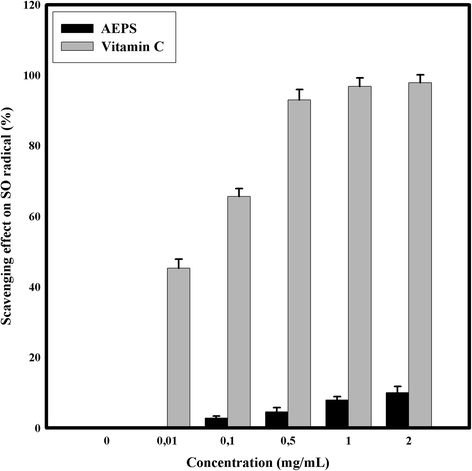Partial characterization and antioxidant and antiproliferative activities of the aqueous extracellular polysaccharides from the thermophilic microalgae Graesiella sp
- PMID: 27405739
- PMCID: PMC4942953
- DOI: 10.1186/s12906-016-1198-6
Partial characterization and antioxidant and antiproliferative activities of the aqueous extracellular polysaccharides from the thermophilic microalgae Graesiella sp
Abstract
Background: For thousands of years, Tunisian geothermal water has been used in bathing. Indeed, thermal baths "Hammam" were recommended in the treatment of different type of illnesses as, for instance, for relaxing joints and soothing. The ability of microalgae to sustain at the high temperature makes them potential producers of high value thermostable bio-products. This study aimed to explore the therapeutic potential of the aqueous extracellular polysaccharides (AEPS) of the Tunisian thermophilic microalgae Graesiella sp. and to evaluate its physico-chemical characteristics.
Methods: Different parameters were used to characterize the AEPS. The dry weight, volatile dry weight, elemental analysis, monosaccharide composition and IR-spectroscopy analysis. Carbohydrate, uronic acid, ester sulfate and protein concentrations were also determined using colorimetric assay. AEPS was analyzed for its antioxidant propriety by means of total antioxidant capacity, DPPH radicals scavenging assay, ferrous chelating ability and hydroxyl and superoxide radical scavenging activity. The antiproliferative activity of AEPS was evaluated for HepG2 and Caco-2 cells using the MTT assay.
Results: The Graesiella sp. AEPS is found to be a hetero-sulfated-anionic polysaccharides that contain carbohydrate (52 %), uronic acids (23 %), ester sulfate (11 %) and protein (12 %). The carbohydrate fraction was formed by eight neutral sugars glucose, galactose, mannose, fucose, rhamnose, xylose, arabinose and ribose. The FT-IR revealed the presence of carboxyl, hydroxyl, amine and sulfate groups. AEPS showed high activity as reducing agent, high ferrous chelating capacity and caused a significant decrease in a concentration-dependent manner of hydroxyl radical. A moderate DPPH scavenging activity and a poor superoxide radical scavenging ability were also observed. AEPS treatment (from 0.01 to 2.5 mg/ml) caused also a clear decrease of cell viabilities in a dose-dependent manner. The IC50 values obtained in HepG2 and Caco-2 cells were 1.06 mg/ml and 0.3 mg/ml respectively.
Conclusions: This study evidenced that the Graesiella sp. AEPS exhibits antioxidant and antiproliferative activities. The biological activities of this extract depend on its fine structural features. Further work will identify and purify the active polysaccharides to enhance our understanding of their complete structure and relationships with its function.
Keywords: Biological activities; Graesiella sp.; Microalgae; Sulfated exopolysaccharides; Tunisian hot spring.
Figures






References
-
- Koller M, Muhr A, Braunegg G. Microalgae as versatile cellular factories for valued products. Algal Res. 2014;6:52–63. doi: 10.1016/j.algal.2014.09.002. - DOI
-
- Seckbach J. Algae and cyanobacteria in extreme environments. 1. Netherlands: Springer; 2007.
MeSH terms
Substances
LinkOut - more resources
Full Text Sources
Other Literature Sources
Medical

